Diversity, equity, and inclusion (DEI) training is an educational course or program within a company that allows employees to learn about and experience the backgrounds and cultures of their colleagues. This type of initiative promotes awareness, inclusion, and understanding of the diverse backgrounds of all individuals.
Diversity, equity, and inclusion in the workplace are defined as:
- Diversity: The practice of including or involving people from different social and ethnic backgrounds, and of different genders and sexual orientations, in teams and decision-making processes.
- Equity: The quality of being fair and impartial, and adjusting the treatment of individuals with different backgrounds so that experiences equal the outcomes.
- Inclusion: The action of providing equal opportunities within a group and actively including people of all backgrounds by creating a psychologically safe environment where everyone can participate.
DEI training enables employees to recognize their biases and challenges them to cultivate environments where everyone feels valued. It can result in increased employee engagement, higher recruitment and retention, and overall well-being.
Types of DEI Training
There are different types of training that represent a varied spectrum of diversity, equity, and inclusion—everything from allyship training and anti-harassment to cultural competence and unconscious bias. Expand each training type below to learn more.
For employees without disabilities, it may be difficult to understand the biases that exist within a company. Accessibility training can highlight areas where discrimination, harassment, or bias against those with disabilities may be present.
Workplace scenarios and facilitated conversations can help employees understand the biases that exist for disabled individuals.
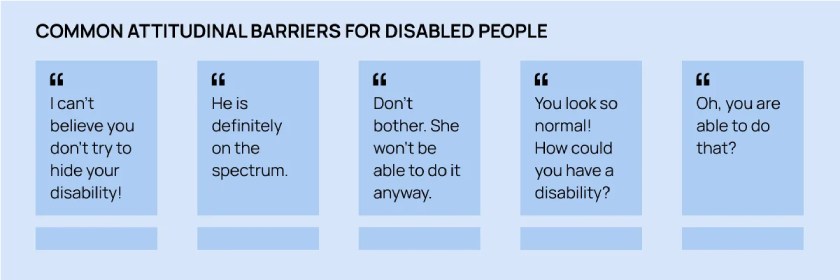
Accessibility training can allow employees to see behaviors that may be considered barriers. (Source: SBBC)
This type of training helps create increased opportunities for traditionally underrepresented groups, such as women, different races, and those with disabilities. It can result in improved performance and a heightened sense of success within their role.
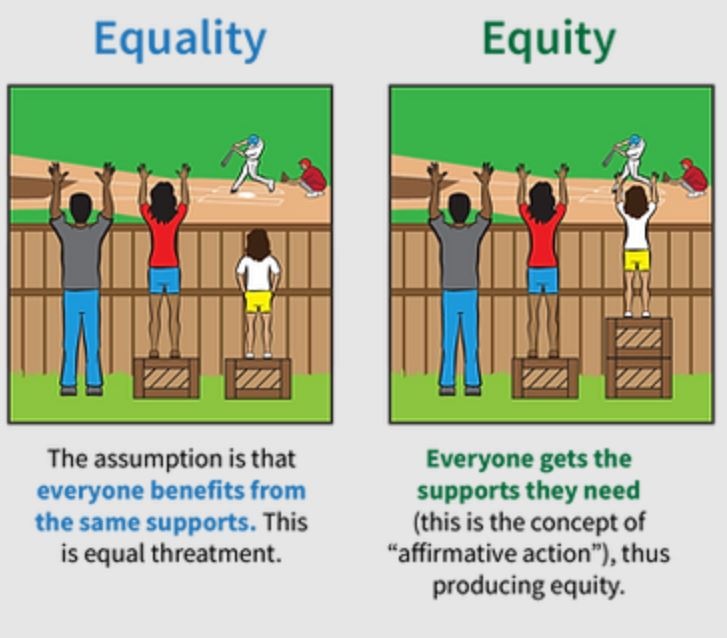
Affirmative Action training shows employees how they can offer the support needed for every type of employee. (Source: Indiana Arts Commission)
According to Kelly McDonald, author of four best-selling business books and owner of McDonald Marketing, merit threat is when someone feels that recognizing the existence of bias, discrimination, and inequity “explains away” their own successes. It’s the perception that their achievements are not the result of their hard work and talent, but rather, their racial, gender, generational or other status.
Regular training and education can help dispel myths about reverse discrimination and merit threats and create a culture of understanding. Use real-world examples to make training interactive and engaging.
Your workforce is likely made up of employees of varying ages. Because of this, it’s important to train your staff to show equality when it comes to someone’s age. Just because someone is younger doesn’t mean they can work faster. And, just because someone is older doesn’t mean they automatically have more knowledge than others.
Make sure your training encompasses how to work with individuals of all ages. You can demonstrate this with workplace scenarios that show interactions with different ages within the workplace and direct knowledge to discuss each.
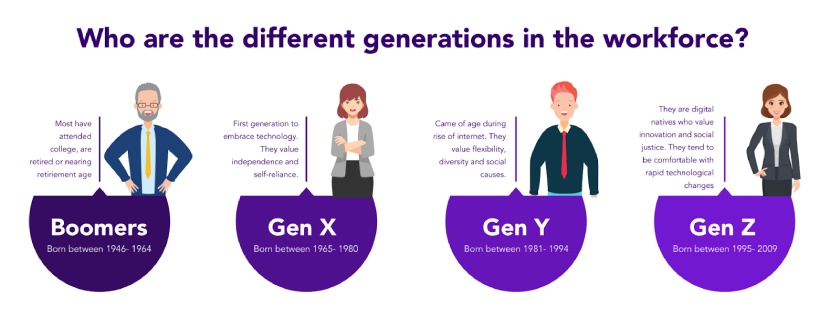
Age Diversity training can help employees recognize the differences in how each generation may learn and view their jobs. (Source: LinkedIn)
There are different types of allyship—LGBTQ+, mental health, and acceptance of all diverse groups.
Almost 8% of the US population is made up of the LGBTQ+ community. LGBTQ+ refers to those that identify as lesbian, gay, bisexual, transgender, queer, and more. One in five Gen Zers, the newest generation coming into the workforce, identify as LGBTQ+. Therefore, it is important to incorporate allyship training into your DEI efforts.
You can do this by providing workplace scenarios that shed light on how you can be an ally to someone in the LGBTQ+ community. Additionally, offer your employees a chance to self-reflect on areas where they may be able to show acceptance and inclusion to others.
Additionally, your employees’ mental health and well-being are vital to having an engaged and productive team. It is a matter of being aware of how your employees are feeling. While this is generally an innate skill, it can be taught to a certain degree.
Self-guided learning is the best option in this situation. Employees can absorb the information at their own pace and have time for self-reflection on the materials.
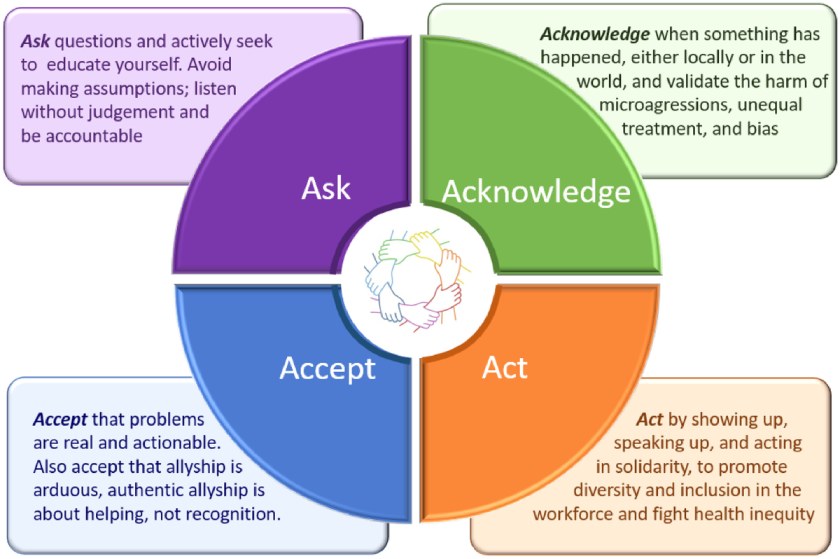
Allyship training helps employees understand how to interact with different demographics through asking, acknowledging, accepting, and acting. (Source: Springer Link)
While anti-harassment training is typically its own program, it should also be combined with your diversity training. It’s important to be clear that harassment is a form of discrimination and is especially wrong when an employee is harassing someone based on their age, race, sexual identity, or culture.
Parts of your training should focus on every type of harassment, and one part should focus solely on sexual harassment. You can provide this type of training in word problem format and have your employees choose the statements that are considered harassment.
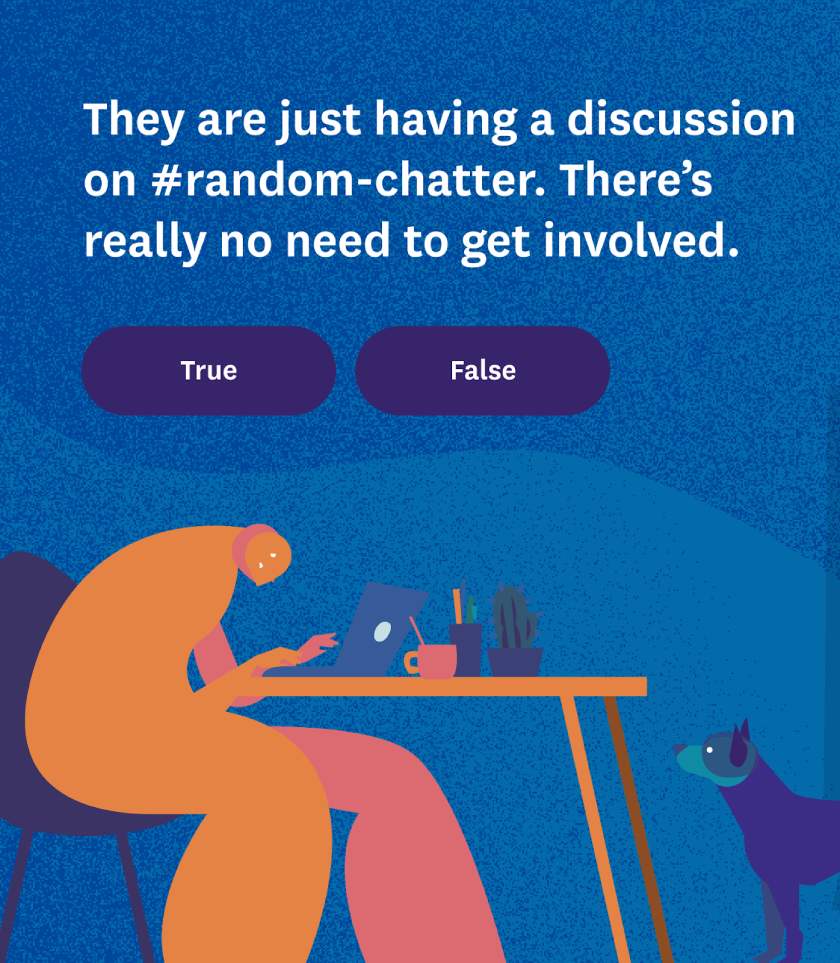
Anti-harassment training can provide real-world scenarios where employees can determine if they are witnessing harassment. (Source: TalktoSpot)
Cultural competence involves the ability to engage effectively and respectfully with individuals from varied backgrounds. Training employees in cultural competence is crucial, especially for companies with a global workforce, as it enhances team cohesion and drives innovation.
For this type of training, we recommend a direct knowledge approach that discusses communication styles, self-identity, and conflict resolution with different cultures. This will help your employees understand how other cultures are different from each other, and how they interweave into a united culture.
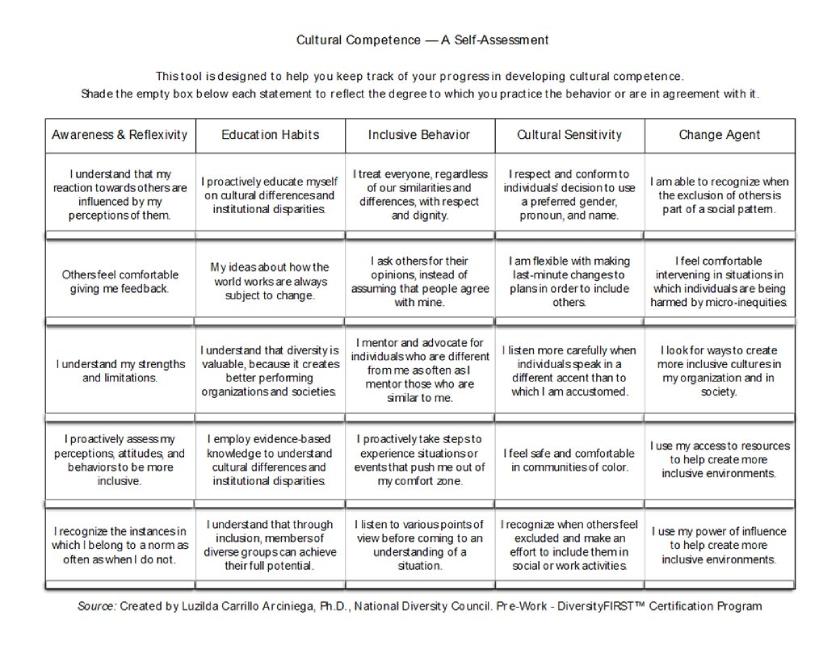
Cultural Competence should be taught as self-assessment learning. (Source: DiversityFIRST)
An equal opportunity means that you hire people based on their qualifications for the job and not the way they look, their race, or any other physical attribute they may possess. Equal opportunity also means that within a company each individual has the chance to grow and be promoted without bias.
Equal opportunity training can be part of a larger area of your DEI training that shows employees they are valued and worthy of shared experiences.
Equal Opportunity training should show examples of how to include others. (Source: SlideTeam)
DEI training sessions that focus on inclusive leadership give an opportunity to create an environment where every team member feels valued, heard, and appreciated for their contributions. By training your leaders to be inclusive, you are breaking down barriers and encouraging accountability.
You can incorporate inclusive leadership training into your DEI initiatives by using storytelling as a tool for connection and understanding. Encourage your leaders to share personal stories that reveal their journeys with bias and inclusivity. This allows employees to see the human side of leadership and fosters empathy and vulnerability within the team. It also creates an atmosphere where open dialogue is encouraged.
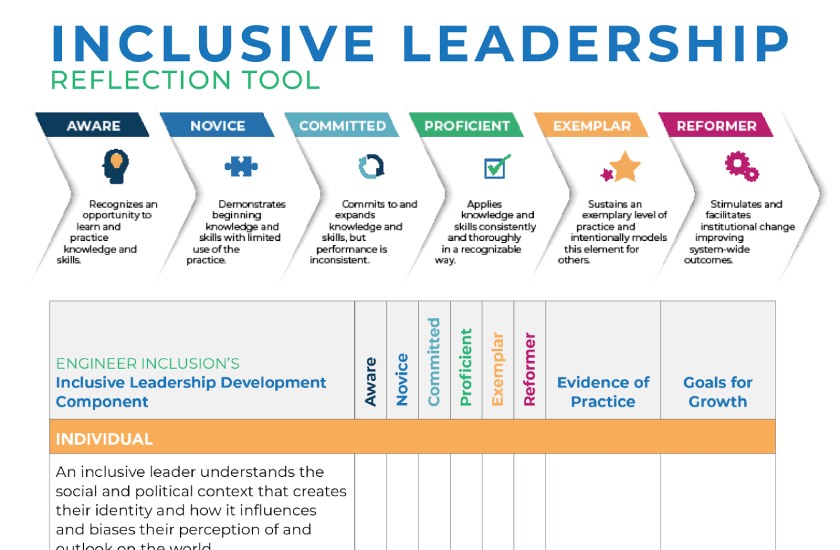
Inclusive Leadership training should offer leaders the opportunity to self-evaluate. (Source: Engineer Inclusion)
Microaggressions can be small instances of passive-aggressive or aggressive behavior where an employee makes offensive comments about someone’s race, age, gender, and various diversity factors. They often present as off-handed comments or jokes that are inappropriate. Many times, the offender isn’t even aware they are making inappropriate comments.
In your DEI training, you can show real-life examples of microaggression through video. Explain to your staff why these types of comments or jokes may be considered harassment to employees and why they should refrain from making them.
It’s important not to call out any specific individuals who may exhibit this behavior in front of the group. However, it is appropriate to have HR speak with the individual and let them know that type of behavior will not be tolerated in the workplace.
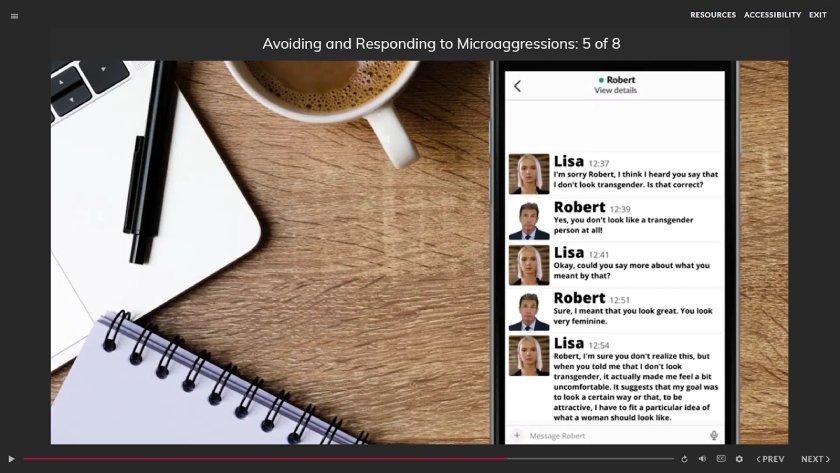
Preventing Microaggressions training is best given as scenarios and outcomes. (Source: Traliant)
This type of DEI training for employees sheds light on different religions within your organization. It can help employees be sensitive to cultural differences and understand how other religions celebrate.
You can incorporate this throughout your training by highlighting religious observances and providing the history of each religion. The best way to convey this is through direct knowledge and simply telling your employees the information they need to know. Have them explore the similarities and differences between different religions.
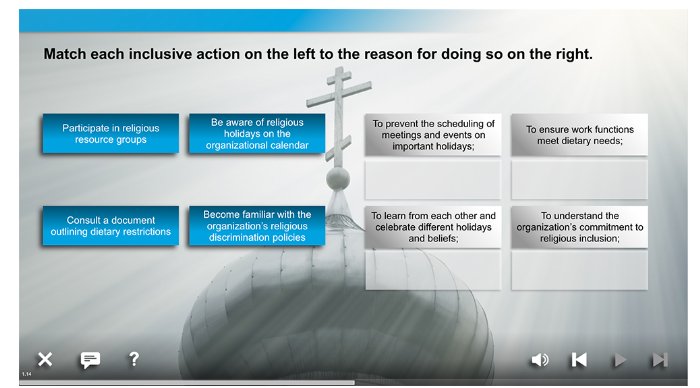
Religious Sensitivity training should include examples of all types of religion. (Source: Diversity Resources)
Addressing unconscious bias is not just about raising awareness, but creating an ongoing dialogue that encourages self-reflection and active change. By including unconscious bias, such as gender, affinity, or beauty, in your DEI training, you can prioritize a safe space where employees can explore their biases without fear of judgment. It also allows employees to see where a bias is that they may not have been aware of.
By using real-life scenarios and interactive case studies, you can show your employees examples of where unconscious bias can seep into their everyday work lives. Use storytelling techniques to share how true experiences reveal unconscious bias and shape interactions and decision-making processes. Then, allow your employees to self-reflect on where unconscious bias may lie within their personal and work lives.

Unconscious Bias training is best in group discussions. (Source: Symonds Research)
The Importance of DEI Training
DEI training is important because it builds the foundation for a strong company culture, addresses existing and future biases, improves employee engagement, and helps with overall hiring and retention efforts.
- Improved company culture: When employees with different backgrounds and cultures collaborate, it can help boost creativity and innovation, thus improving your overall company culture.
- Stronger communication: When your employees actively listen to understand individual differences, it can increase the communication lines between team members.
- Improved hiring and retention: A diverse company that values the uniqueness of every team member creates a desired company image that job seekers are attracted to. Additionally, when team members are valued they are more likely to stay with your company long term.
- Increased productivity: When employees understand how to work with each other, it leads to a positive experience where each person has a sense of belonging and feels they are treated equally. This leads to increased productivity because employees are more satisfied with their work.
What to Include in DEI Training
Just because you have a diverse workforce doesn’t mean you’ve built an inclusive culture. That is where DEI training for employees comes in, to help you recognize and correct any potential barriers to equity and inclusion. To enhance your DEI training, consider implementing the following:
- Direct knowledge: This type of training is simply providing factual information about a subject (e.g., different religions or cultures).
- Facilitated conversations: These are generally group discussions where a mediator controls the narrative and allows members of the group to voice their opinions.
- Workplace scenarios: You can create or show videos of real-life scenarios that may take place in the workplace and discuss with your employees how certain behaviors can lead to harassment and bias.
- Self-guided learning: Your employees will review materials at their own pace (typically within a certain timeframe).
- Role-specific training: Train employees on how to communicate with diverse team members and clients while performing their specific duties.
- Interactive case studies: Use real-life case studies or virtual reality training that exhibit the diverse training you are trying to convey. You can make it interactive by involving employees in discussions and role-play.
- Self-reflection: Allow your employees to reflect on their own behaviors and patterns. This is typically in the form of a written response.
- Comprehension checks: Be sure your training has some sort of grading system so that you can measure the employees’ comprehension of the subject matter. This can include a quiz at the end of each section, a final exam at the end of the course, homework to complete, or guided discussion groups.
How to Build a Successful DEI Training Program
A successful DEI training program needs direction. Consider the following when creating your program.
1. Form a DEI Committee
A successful DEI training program starts with leadership. Gather a group of leaders and employees to form a committee dedicated to diversity, equity, and inclusion.
2. Assess Your Current Culture
The first step to building a diversity, equity, and inclusion training program is to take a pulse on your current culture. Your core values, part of your company culture, should include diverse measures to make everyone feel included. If you haven’t outlined the core values of your company, now is a good time to evaluate those.
In your culture assessment, ask yourself these questions:
- Is the company inclusive of all types of employees?
- Does the company value individual uniqueness?
- Is the company currently diverse in nature?
- Does the company encourage teamwork and collaboration?
- Does the company currently have measures in place to celebrate employee differences?
3. Determine Training Types
Once you’ve taken a look at where your company culture currently stands, and where you want it to go, decide what type of training technique you want to hold. This could be in-person training, video training, or self-paced courses.
Dr. Cheryl Ingram, DEI strategist and President of Inclusologist, says DEI training should never be cookie-cutter. You’re training engineers? Inject DEI into their data analysis. Training executives? DEI has to connect to leadership, growth, and the business case. Respect people’s learning styles–some need videos, others need role-playing. Part of practicing DEI is recognizing diversity in how people learn.
See our list above for examples of the types of DEI training you can implement into your program. And, for more information on training, check out our articles on training and development or types of employee training methods (with free plan template).
4. Ensure Legal Practices
While there are no federal laws that regulate DEI training initiatives, there are some federal labor laws that you need to be aware of.
Protects employees from discrimination based on protected classes, like race, color, sexual orientation, age, religion, and national origin. | |
Prohibits employers from discriminating against individuals older than 40 years of age. | |
Protects individuals with physical and mental disabilities. | |
Ensures workers have the right to work in the United States. | |
Protects pregnant employees from discrimination. |
Additionally, there are more than 30 bills on the state level, mostly geared towards mandatory DEI trainings in schools, that have strict laws on the content and topics that can be included in DEI training. Those already signed into law include Florida, Alabama, North Dakota, South Dakota, Tennessee, Texas, Utah, Idaho, Kansas, and Iowa.
Other states have both mandatory anti-harassment and sexual harassment training. These include California, Connecticut, New York, Illinois, Maryland, Minnesota, New Jersey, Oregon, and Washington. We recommend having an attorney review your DEI training materials to ensure legal compliance.
5. Measure Performance and Engagement
Your job isn’t over when the training is complete. Continue to assess your training, evaluate employee engagement, and measure your performance throughout. You can measure the success of your DEI training by evaluating the following:
- Compensation: Run compensation analysis reports to determine if you are offering fair pay to each employee, based on role only. A great way to measure this is by using salary comparison tools.
- Engagement: Employees who feel included are more engaged in their work and with coworkers. Conduct employee engagement surveys to see where your culture still needs improvement.
- Productivity: When employees are happy they generally perform better. Following your DEI training, evaluate employee performance and productivity to determine if this has increased.
- Metrics: HR can run workforce demographics and return-on-investment (ROI) reports to see the company’s inclusivity efforts.
DEI Training Frequently Asked Questions (FAQs)
Yes! DEI training ensures your employees are equipped with the tools and knowledge to be inclusive and embrace the diversity of their colleagues. While it will cost a bit upfront to get the program running, the outcome will lead to an engaged workforce and increased productivity.
One potential downside is the possibility of missing a diversity group and therefore excluding certain employees. To decrease the chances of this happening, be sure your DEI training is comprehensive and includes all socioeconomic and cultural backgrounds within your employee base.
The price of DEI training depends on the resources used. Using your current employees to create and manage your DEI program will cost the salary of the employees involved. If you choose to outsource your DEI training it can cost anywhere from a few hundred dollars to a few thousand. Check into your payroll provider as well; some, like Gusto, offer DEI and state-mandated training included in their services.


